#IT and infrastructure
Explore tagged Tumblr posts
Text
i had a thought of "do people not know what AUs are anymore?" and then i remembered nobody explains fandom stuff to new people anymore so it is entirely plausible people genuinely don't know what AUs are and nobody has explained it to them, so for today's lucky 10,000:
"AU" stands for "Alternate Universe" or "Alternative Universe" (same difference) and is basically any thought scenario for a fandom that isn't canon and can't fit within the canon universe. If it takes place in the canon universe but something is notably different, that is typically what's known as a "Canon divergent AU," because it diverges from canon.
an AU can be absolutely anything. There's a couple of widespread pan-fandom au scenarios that often get thrown around, like coffee shop aus, genderbend aus, hanahaki aus (hanahaki is a whole thing in itself i'd recommend researching on your own), etc. One you might hear sometimes is "crossover AU" which is when you have characters from one fandom interacting with characters from another.
You can have as many aus as you want. They can be whatever you want and you can do whatever you want in them. It's a sandbox for you to play around in and explore how things would be different or how the characters would act in those circumstances or environments. Maybe they have different relationships with each other. Maybe they behave slightly differently. Or you can just say "Okay, [x] is true. How did they get here? How would things have to be different for this to occur?" which can also be fun.
If you are ever confused about why people ship something that seems completely out of the blue or doesn't make sense to you in the canon setting, there's a good chance they like it in an AU setting! Not everything everybody is interacting with is necessarily the canon! Not everybody wants things to exist in canon and just want to explore playing dolls in a different sandbox and that's okay. And their sandbox might look a lot different than yours, and that's also okay. You have the freedom to make your sandbox whatever you please. Do whatever you want forever. Get funky with it. AUs are fun.
Okay that's my schpeal. everybody go have fun and play nice now.
#fandom#fandom infrastructure#fandom history#was working on the ship polls blog and the comments i get there often reminded me of this#every once in a while i've gotta reacquaint myself with the xkcd expert familiarity comic principle#and the general knowledge that people dont explain the basics of fandom anymore so people have to learn it on their own#while everybody just expects them to know it and that's not fair to them!#i will also put my usual thing: folks are always welcome to ask me anything about fandom stuff#it can be specific pjo fandom stuff or general pan-fandom stuff#i have been in fandom for a long time and i am happy to explain things#legitimately if anyone ever has questions about even the most basic of fandom stuff. go for it. i love talking about it
9K notes
·
View notes
Text


Pictured: Luis Cassiano is the founder of Teto Verde Favela, a nonprofit that teaches favela residents in Rio de Janeiro, Brazil, how to build their own green roofs as a way to beat the heat. He's photographed at his house, which has a green roof.
Article
"Cassiano is the founder of Teto Verde Favela, a nonprofit that teaches favela residents how to build their own green roofs as a way to beat the heat without overloading electrical grids or spending money on fans and air conditioners. He came across the concept over a decade ago while researching how to make his own home bearable during a particularly scorching summer in Rio.
A method that's been around for thousands of years and that was perfected in Germany in the 1960s and 1970s, green roofs weren't uncommon in more affluent neighborhoods when Cassiano first heard about them. But in Rio's more than 1,000 low-income favelas, their high cost and heavy weight meant they weren't even considered a possibility.
That is, until Cassiano decided to team up with a civil engineer who was looking at green roofs as part of his doctoral thesis to figure out a way to make them both safe and affordable for favela residents. Over the next 10 years, his nonprofit was born and green roofs started popping up around the Parque Arará community, on everything from homes and day care centers, to bus stops and food trucks.
When Gomes da Silva heard the story of Teto Verde Favela, he decided then and there that he wanted his home to be the group's next project, not just to cool his own home, but to spread the word to his neighbors about how green roofs could benefit their community and others like it.

Pictured: Jessica Tapre repairs a green roof in a bus stop in Benfica, Rio de Janeiro, Brazil.
Relief for a heat island
Like many low-income urban communities, Parque Arará is considered a heat island, an area without greenery that is more likely to suffer from extreme heat. A 2015 study from the Federal Rural University of Rio de Janeiro showed a 36-degree difference in land surface temperatures between the city's warmest neighborhoods and nearby vegetated areas. It also found that land surface temperatures in Rio's heat islands had increased by 3 degrees over the previous decade.
That kind of extreme heat can weigh heavily on human health, causing increased rates of dehydration and heat stroke; exacerbating chronic health conditions, like respiratory disorders; impacting brain function; and, ultimately, leading to death.
But with green roofs, less heat is absorbed than with other low-cost roofing materials common in favelas, such as asbestos tiles and corrugated steel sheets, which conduct extreme heat. The sustainable infrastructure also allows for evapotranspiration, a process in which plant roots absorb water and release it as vapor through their leaves, cooling the air in a similar way as sweating does for humans.
The plant-covered roofs can also dampen noise pollution, improve building energy efficiency, prevent flooding by reducing storm water runoff and ease anxiety.
"Just being able to see the greenery is good for mental health," says Marcelo Kozmhinsky, an agronomic engineer in Recife who specializes in sustainable landscaping. "Green roofs have so many positive effects on overall well-being and can be built to so many different specifications. There really are endless possibilities.""
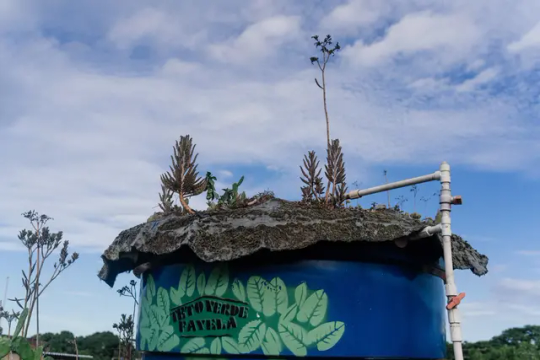
Pictured: Summer heat has been known to melt water tanks during the summer in Rio, which runs from December to March. Pictured is the water tank at Luis Cassiano's house. He covered the tank with bidim, a lightweight material conducive for plantings that will keep things cool.
A lightweight solution
But the several layers required for traditional green roofs — each with its own purpose, like insulation or drainage — can make them quite heavy.
For favelas like Parque Arará, that can be a problem.
"When the elite build, they plan," says Cassiano. "They already consider putting green roofs on new buildings, and old buildings are built to code. But not in the favela. Everything here is low-cost and goes up any way it can."
Without the oversight of engineers or architects, and made with everything from wood scraps and daub, to bricks and cinder blocks, construction in favelas can't necessarily bear the weight of all the layers of a conventional green roof.
That's where the bidim comes in. Lightweight and conducive to plant growth — the roofs are hydroponic, so no soil is needed — it was the perfect material to make green roofs possible in Parque Arará. (Cassiano reiterates that safety comes first with any green roof he helps build. An engineer or architect is always consulted before Teto Verde Favela starts a project.)
And it was cheap. Because of the bidim and the vinyl sheets used as waterproof screening (as opposed to the traditional asphalt blanket), Cassiano's green roofs cost just 5 Brazilian reais, or $1, per square foot. A conventional green roof can cost as much as 53 Brazilian reais, or $11, for the same amount of space.
"It's about making something that has such important health and social benefits possible for everyone," says Ananda Stroke, an environmental engineering student at the Federal University of Rio de Janeiro who volunteers with Teto Verde Favela. "Everyone deserves to have access to green roofs, especially people who live in heat islands. They're the ones who need them the most." ...
It hasn't been long since Cassiano and the volunteers helped put the green roof on his house, but he can already feel the difference. It's similar, says Gomes da Silva, to the green roof-covered moto-taxi stand where he sometimes waits for a ride.
"It used to be unbearable when it was really hot out," he says. "But now it's cool enough that I can relax. Now I can breathe again."
-via NPR, January 25, 2025
#architecture#sustainable architecture#heat islands#urban heat#brazil#brasil#south america#favela#rio de janeiro#green roof#plants#climate action#climate adaptation#infrastructure#good news#hope#solarpunk
5K notes
·
View notes
Text
half a year of unrelenting genocide in Gaza, please don’t stop caring. they are so tired, they cannot be the only ones participating in their own liberation. we have to keep caring
#the genocide has been happening for nearly a century but it has been six months since October and the deliberate collapse of Gaza's#infrastructure at the hands of isr@el#♥︎
34K notes
·
View notes
Text
How Leading Companies Are Leveraging Infrastructure as a Service (IaaS)
As businesses increasingly turn to digital solutions, Infrastructure as a Service (IaaS) has emerged as a vital component for modern enterprises. By utilizing cloud platforms, companies can enhance their agility, scalability, and cost-efficiency. This article explores infrastructure as a service examples and how leading companies are leveraging IaaS providers to drive innovation and growth.
What is Infrastructure as a Service (IaaS)?
IaaS is a cloud computing service model that delivers virtualized computing resources over the internet. It enables businesses to rent infrastructure components like servers, storage, and networking, rather than investing in physical hardware. This flexibility allows companies to scale resources according to their needs and focus on core activities without the burden of managing IT infrastructure.
1. Netflix: Enhancing Scalability and Performance
Cloud Infrastructure Examples
Netflix, the global streaming giant, leverages IaaS to manage its vast content library and ensure seamless streaming experiences for millions of users worldwide. By using IaaS providers like Amazon Web Services (AWS), Netflix can quickly scale its infrastructure to handle peak loads, such as new releases or seasonal spikes in viewership. This scalability ensures high performance and availability, crucial for maintaining customer satisfaction.
2. Airbnb: Optimizing Resource Management
IaaS Use Cases
Airbnb, the popular online marketplace for lodging, utilizes IaaS to manage its global operations. The company employs cloud services examples like dynamic scaling to match infrastructure resources with fluctuating demand. During peak travel seasons or significant events, Airbnb can scale up its infrastructure to accommodate increased traffic, ensuring reliable service and user experience.
3. Slack: Ensuring Data Security and Compliance
Cloud Platforms
Slack, a leading collaboration platform, relies on IaaS for data security and regulatory compliance. By partnering with IaaS providers like Google Cloud Platform (GCP), Slack benefits from advanced security features, including encryption and compliance with industry standards such as GDPR and HIPAA. This ensures that sensitive business communications remain secure and compliant with regulations.
4. Pinterest: Enhancing Development and Innovation
IaaS Providers
Pinterest, a visual discovery and bookmarking platform, leverages IaaS to accelerate development cycles and foster innovation. Using cloud platforms like Microsoft Azure, Pinterest provides its developers with the tools and resources needed to build, test, and deploy new features rapidly. This agile development environment supports continuous improvement and innovation.
5. Spotify: Delivering Seamless Music Streaming
Cloud Infrastructure Examples
Spotify, the music streaming service, utilizes IaaS to manage its extensive music catalog and deliver high-quality streaming experiences. By using cloud platforms like Google Cloud, Spotify ensures that users can access their favorite music anytime, anywhere. The scalable infrastructure allows Spotify to handle millions of concurrent users without compromising performance.
6. Coca-Cola: Supporting Global Operations
IaaS Use Cases
Coca-Cola, a global beverage leader, uses IaaS to support its worldwide operations. By partnering with IaaS providers like IBM Cloud, Coca-Cola manages its supply chain, customer data, and digital marketing initiatives across different regions. This integrated approach enables Coca-Cola to maintain consistency and efficiency in its global operations.
7. Twitter: Managing Real-Time Data
Cloud Services Examples
Twitter, the social media platform, leverages IaaS to manage and process vast amounts of real-time data. Using cloud platforms like AWS, Twitter can handle high volumes of tweets, mentions, and user interactions with minimal latency. This capability is crucial for delivering real-time updates and maintaining user engagement.
8. General Electric: Facilitating Industrial IoT
IaaS Providers
General Electric (GE) uses IaaS to power its Industrial Internet of Things (IIoT) initiatives. By utilizing cloud platforms like Microsoft Azure, GE connects industrial equipment and collects data to optimize performance and predict maintenance needs. This data-driven approach enhances operational efficiency and reduces downtime.
9. eBay: Ensuring High Availability
Cloud Infrastructure Examples
eBay, the e-commerce giant, employs IaaS to ensure high availability and reliability for its global marketplace. By using IaaS providers like AWS, eBay can quickly scale its infrastructure to handle large volumes of transactions and user interactions. This reliability is essential for maintaining trust and satisfaction among buyers and sellers.
10. Zoom: Supporting Remote Communication
IaaS Use Cases
Zoom, the video conferencing service, relies on IaaS to support its global user base. By leveraging cloud platforms like Oracle Cloud, Zoom ensures high-quality video and audio communication, even during peak usage times. This scalability and reliability are critical for supporting remote work and virtual events.
Conclusion
Leading companies across various industries are leveraging Infrastructure as a Service (IaaS) to enhance scalability, performance, security, and innovation. By partnering with top IaaS providers and utilizing cloud infrastructure services, these businesses can stay agile, competitive, and responsive to market demands. Whether it's optimizing resource management, ensuring data security, or supporting global operations, IaaS provides the flexibility and power needed to drive business success in the digital age.
#aws web services#saas#aws amazon web services#data centres#iaas infrastructure as a service#aws cloud computing#azure cloud#saas services#platform as a service examples#saas cloud#IT infrastructure as a service#iaas as a service#infrastructure as a service examples#information technology IT infrastructure#IT and infrastructure#aws global infrastructure#azure services#platform as a service#infrastructure as a cloud#IT infra service#data center and cloud computing#cloud based data centers#aws infrastructure#aws datacenter#azure cloud services#amazon web services in cloud computing#platform as a service in cloud computing examples#digital infrastructure#microsoft azure cloud#aws connect
1 note
·
View note
Text
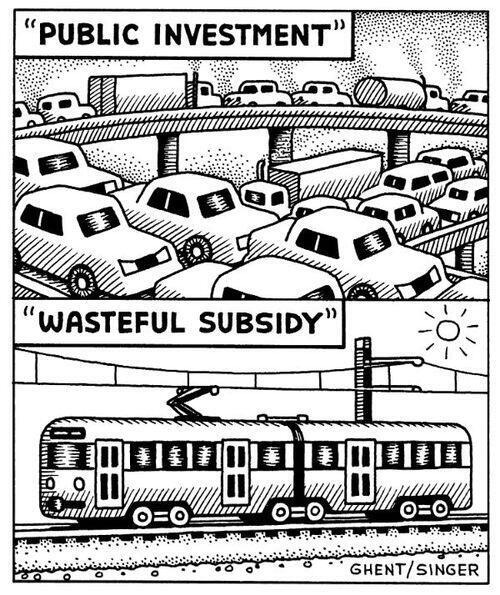
Comic by Andy Singer
19K notes
·
View notes
Text
Just a reminder to my European followers that the European Parliament elections are coming up and they are very important! The far-right parties are projected to win a lot of seats and many of the left/environmentalist parties are expected to do poorly.
This could have serious implications for major issues like climate action in the EU. It is very important that young people turn out to vote, EU elections typically have relatively low turnout but the composition of the EU Parliament does impact the lives of people in the European Union in a lot of ways.
#also if you're in Ireland vote in the local elections coming up as well#do you cycle?#do you want to be able to cycle on the roads without getting flattened?#vote for city council candidates that will vote for safe cycling infrastructure#EU#European Parliament
7K notes
·
View notes
Text
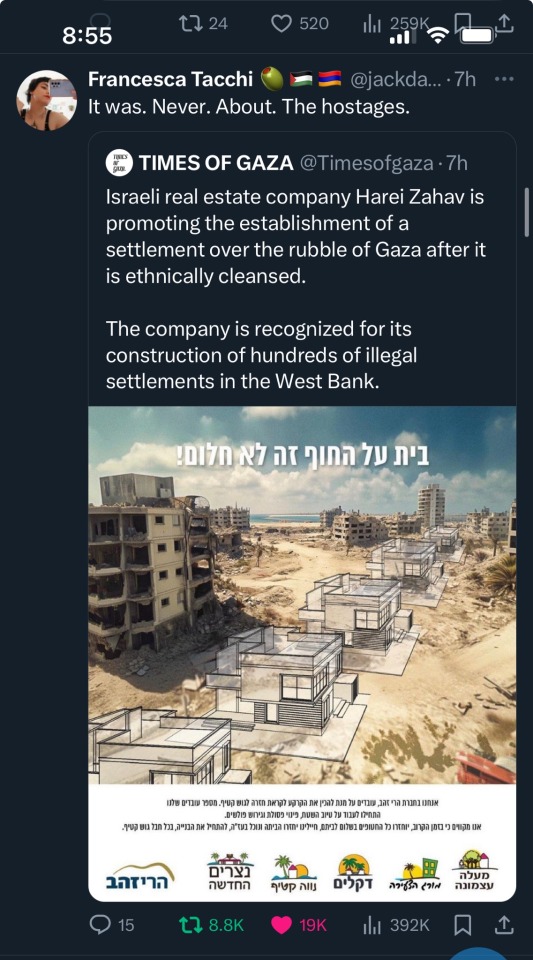
This genocide never has been about the hostages, never will be about the hostages.
Mind you, the IDF shot and killed three hostages today. (They spoke Hebrew and held up a white flag in surrender btw).
If you still think this is about the hostages you are gravely mistaken and your ignorance is profound. 🇵🇸
#israel#israel occupation#ethnic cleansing#israeli hostages#Harei Zahav#real estate#infrastructure#genocide#from the river to the sea palestine will be free#free palestine#free gaza#gaza#palestine#pray for palestine#ceasefire#permanent ceasefire#capitalism#imperialism#colonialism#colonial violence#colonization#america#usa#israel is committing genocide#israel is a terrorist state
7K notes
·
View notes
Text
You ever look at the road planning of a Southern US city and think to yourself, “there are some countries where an urban planner would go to jail for planning a city like this”
2K notes
·
View notes
Text
thing is - and hear me out - if s3 does by any minute chance incorporate any suggestion of a sex scene, it is imperative for me that they commit to the bit. i need crowley to nearly topple over trying to get out of his jeans, i need aziraphale to complain that they cant do anything downstairs because that would be scandalous, and i need them to trip over going up the stairs because they keep getting distracted. i need one of them to accidentally get an elbow to the face, i need them to have a long forgotten book digging into one of their backs, and aziraphale is horrified when crowley launches it across the room, and i need there to be hard cut to whickber street having a huge power surge, lines sparking, all the power going out, and every car alarm in a 2-mile radius start screaming, i don't need it to be explicit or overly romantic but i do need it to be fucking funny
#will a sex scene happen? eh idk#if it does do i need it to be hysterical and imply that london and wider uk infrastructure goes into meltdown? absolutely#good omens
18K notes
·
View notes
Text
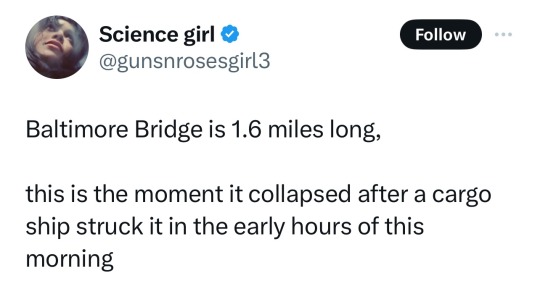
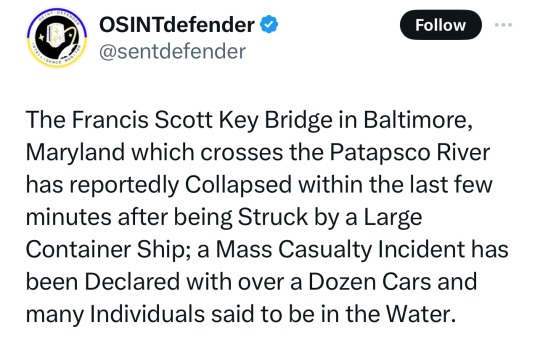
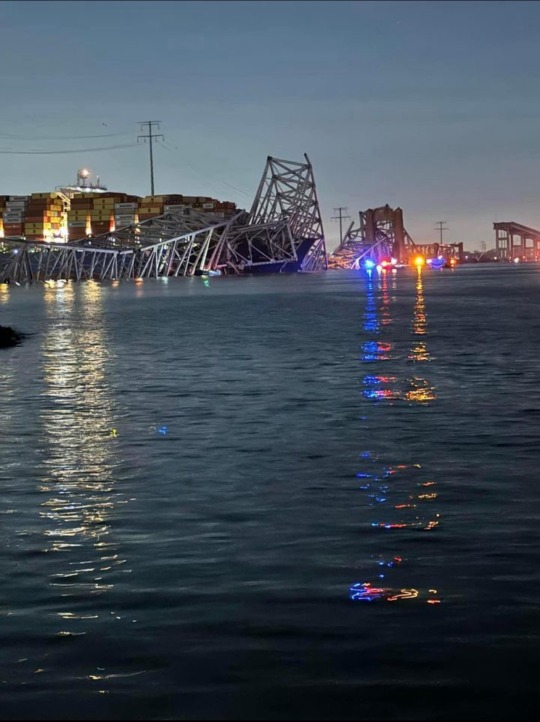
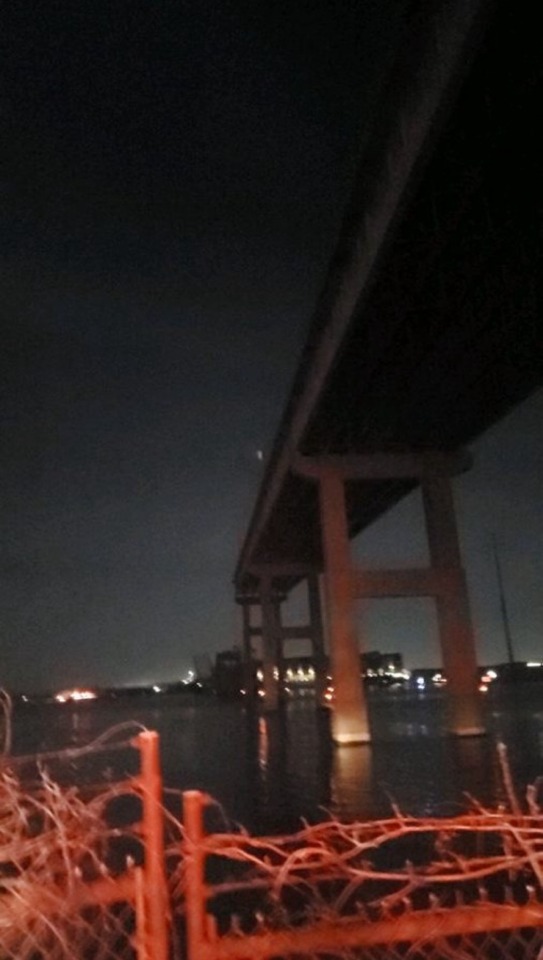
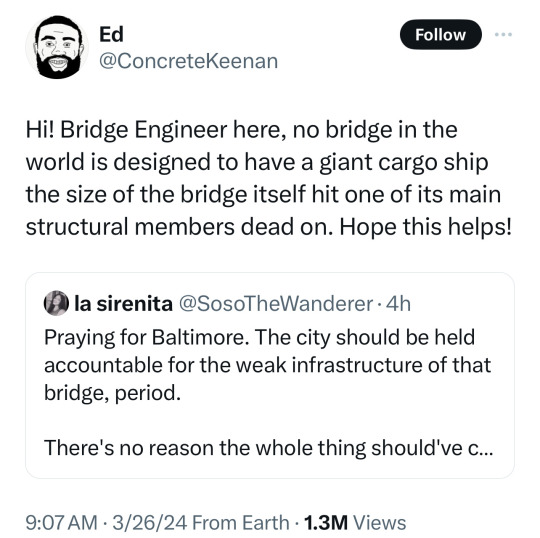

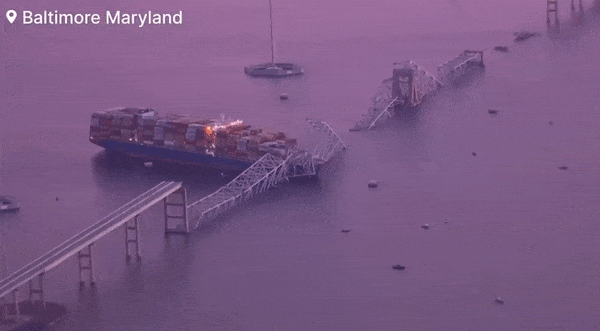


The crew of a massive container ship that crashed into the Francis Scott Key bridge in Baltimore early Tuesday warned of power issues before the collision, which caused the bridge to collapse into the frigid Patapsco River, officials said.
Maryland Gov. Wes Moore said the warning from the ship’s crew likely saved lives.
“We’re thankful that between the mayday and the collapse, that we had officials who were able to begin to stop the flow of traffic so more cars were not on the bridge,” Moore said. He called those officials heroes.
Moore noted that the bridge was up to code at the time of the collapse. He said the collapse was a “shocking and heartbreaking” event for the people of Maryland who have used the bridge for 47 years.
(continue reading)
#i was in dc this weekend for a funeral#we bounced over to baltimore to visit some family friends from childhood#i drove over that bridge twice!!#francis scott key bridge#baltimore#bridge collapse#baltimore bridge#glen burnie#i dont think it was an infrastructure problem#but if oversized cargo ships can gain that much momentum#then maybe they should be required to come to a complete stop#prior to going under a commuter bridge#that or maximum ship size requirements by bridge#or maybe use tugboats??#it seems more like a regulation issue#and yes - even if it was an accident#someone still needs to be held accountable#or it may happen again#a very similar incident happened in my hometown#i think about 4 or 5yrs before i was born#sunshine skyway bridge
4K notes
·
View notes
Text
As relentless rains pounded LA, the city’s “sponge” infrastructure helped gather 8.6 billion gallons of water—enough to sustain over 100,000 households for a year.
Earlier this month, the future fell on Los Angeles. A long band of moisture in the sky, known as an atmospheric river, dumped 9 inches of rain on the city over three days—over half of what the city typically gets in a year. It’s the kind of extreme rainfall that’ll get ever more extreme as the planet warms.
The city’s water managers, though, were ready and waiting. Like other urban areas around the world, in recent years LA has been transforming into a “sponge city,” replacing impermeable surfaces, like concrete, with permeable ones, like dirt and plants. It has also built out “spreading grounds,” where water accumulates and soaks into the earth.
With traditional dams and all that newfangled spongy infrastructure, between February 4 and 7 the metropolis captured 8.6 billion gallons of stormwater, enough to provide water to 106,000 households for a year. For the rainy season in total, LA has accumulated 14.7 billion gallons.
Long reliant on snowmelt and river water piped in from afar, LA is on a quest to produce as much water as it can locally. “There's going to be a lot more rain and a lot less snow, which is going to alter the way we capture snowmelt and the aqueduct water,” says Art Castro, manager of watershed management at the Los Angeles Department of Water and Power. “Dams and spreading grounds are the workhorses of local stormwater capture for either flood protection or water supply.”
Centuries of urban-planning dogma dictates using gutters, sewers, and other infrastructure to funnel rainwater out of a metropolis as quickly as possible to prevent flooding. Given the increasingly catastrophic urban flooding seen around the world, though, that clearly isn’t working anymore, so now planners are finding clever ways to capture stormwater, treating it as an asset instead of a liability. “The problem of urban hydrology is caused by a thousand small cuts,” says Michael Kiparsky, director of the Wheeler Water Institute at UC Berkeley. “No one driveway or roof in and of itself causes massive alteration of the hydrologic cycle. But combine millions of them in one area and it does. Maybe we can solve that problem with a thousand Band-Aids.”
Or in this case, sponges. The trick to making a city more absorbent is to add more gardens and other green spaces that allow water to percolate into underlying aquifers—porous subterranean materials that can hold water—which a city can then draw from in times of need. Engineers are also greening up medians and roadside areas to soak up the water that’d normally rush off streets, into sewers, and eventually out to sea...
To exploit all that free water falling from the sky, the LADWP has carved out big patches of brown in the concrete jungle. Stormwater is piped into these spreading grounds and accumulates in dirt basins. That allows it to slowly soak into the underlying aquifer, which acts as a sort of natural underground tank that can hold 28 billion gallons of water.
During a storm, the city is also gathering water in dams, some of which it diverts into the spreading grounds. “After the storm comes by, and it's a bright sunny day, you’ll still see water being released into a channel and diverted into the spreading grounds,” says Castro. That way, water moves from a reservoir where it’s exposed to sunlight and evaporation, into an aquifer where it’s banked safely underground.
On a smaller scale, LADWP has been experimenting with turning parks into mini spreading grounds, diverting stormwater there to soak into subterranean cisterns or chambers. It’s also deploying green spaces along roadways, which have the additional benefit of mitigating flooding in a neighborhood: The less concrete and the more dirt and plants, the more the built environment can soak up stormwater like the actual environment naturally does.
As an added benefit, deploying more of these green spaces, along with urban gardens, improves the mental health of residents. Plants here also “sweat,” cooling the area and beating back the urban heat island effect—the tendency for concrete to absorb solar energy and slowly release it at night. By reducing summer temperatures, you improve the physical health of residents. “The more trees, the more shade, the less heat island effect,” says Castro. “Sometimes when it’s 90 degrees in the middle of summer, it could get up to 110 underneath a bus stop.”
LA’s far from alone in going spongy. Pittsburgh is also deploying more rain gardens, and where they absolutely must have a hard surface—sidewalks, parking lots, etc.—they’re using special concrete bricks that allow water to seep through. And a growing number of municipalities are scrutinizing properties and charging owners fees if they have excessive impermeable surfaces like pavement, thus incentivizing the switch to permeable surfaces like plots of native plants or urban gardens for producing more food locally.
So the old way of stormwater management isn’t just increasingly dangerous and ineffective as the planet warms and storms get more intense—it stands in the way of a more beautiful, less sweltering, more sustainable urban landscape. LA, of all places, is showing the world there’s a better way.
-via Wired, February 19, 2024
#california#los angeles#water#rainfall#extreme weather#rain#atmospheric science#meteorology#infrastructure#green infrastructure#climate change#climate action#climate resilient#climate emergency#urban#urban landscape#flooding#flood warning#natural disasters#environmental news#climate news#good news#hope#solarpunk#hopepunk#ecopunk#sustainability#urban planning#city planning#urbanism
14K notes
·
View notes
Text
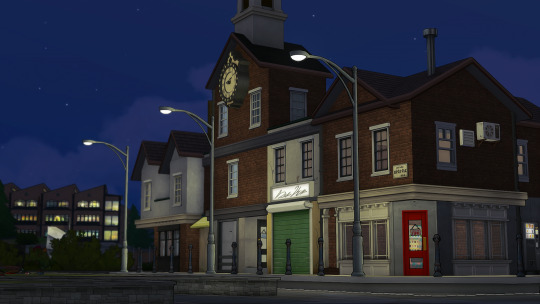
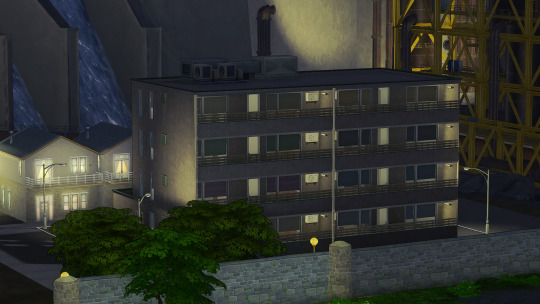
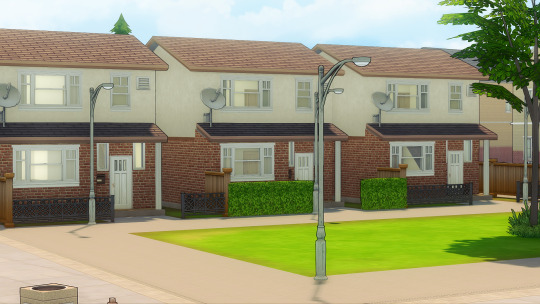
slowly working on a save file
#based on growing up in the uk in the 2000s#garys mod /industrial/ modular/ infrastructure beloved#ts4#the sims 4#mine
920 notes
·
View notes
Text

Source


Source
#capitalism#the left#climate change#climate justice#climate news#twitter post#progressive#current events#news#global warming#green new deal#end capitalism#infrastructure
2K notes
·
View notes
Text






Last week, FEMA announced a nearly $9 billion shortfall for Hurricane Helene recovery efforts. On the same day, Israel announced it was receiving $8.7 billion in military funding from the United States. Since then, Hurricane Helene has devastated communities across six states as flooding stretches for over 600 miles.
The storm’s devastation and lack of government funding for local infrastructure and response has left over 100 people reported dead with hundreds more unaccounted for. Millions of Americans are stranded without water, food, electricity, or gas.
Every dollar the US government spends on genocide in Palestine cannot be used to protect our own communities. The US cannot continue to provide billions of dollars in weapons for Israel’s war crimes in Gaza and Lebanon while Americans suffer from lack of investment here.
We understand this catastrophe within the context of the Israeli government’s genocide and ongoing dispossession of people across the Middle East. We cannot mourn the loss of precious people and places in this country and turn away from the same devastation our tax dollars fund in Palestine and Lebanon.
We cannot separate the climate crisis we’re witnessing at home from the immense damage to the earth the US and Israeli militaries have caused for decades. Israeli colonialism is responsible for the destruction of Palestine’s natural ecological systems and a major contributor to climate change. The US military is the biggest contributor to global climate catastrophe.
Palestinian liberation includes ending the climate crisis and protecting all people — from the US to Palestine. We will not waver in our demand for our government to STOP ARMING ISRAEL and end the preventable deaths of so many across Palestine, Lebanon, and the United States.
#Lebanon#palestine#human rights#free palestine#gaza#israel#gaza genocide#boycott Israel#stop the genocide#stop arming israel#government#us government#us politics#USA#America#hurricane helene#appalachia#infrastructure#healthcare#climate change#climate crisis
2K notes
·
View notes
Text
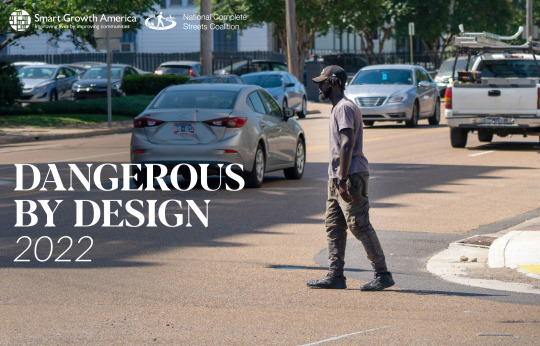
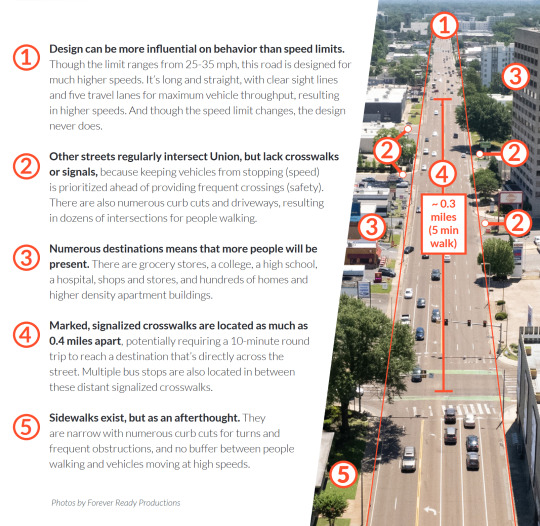




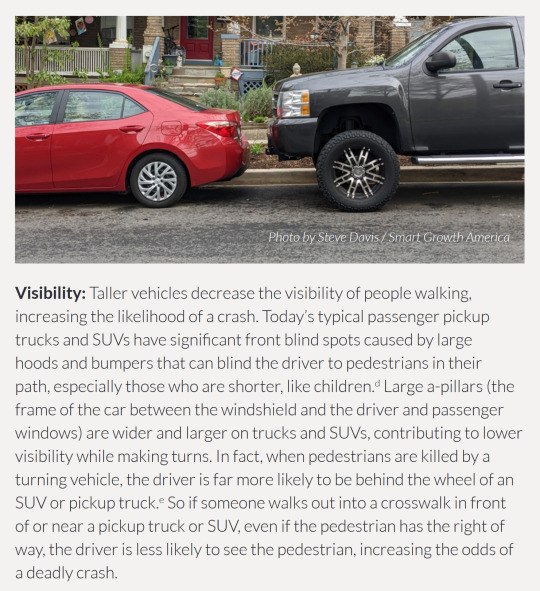


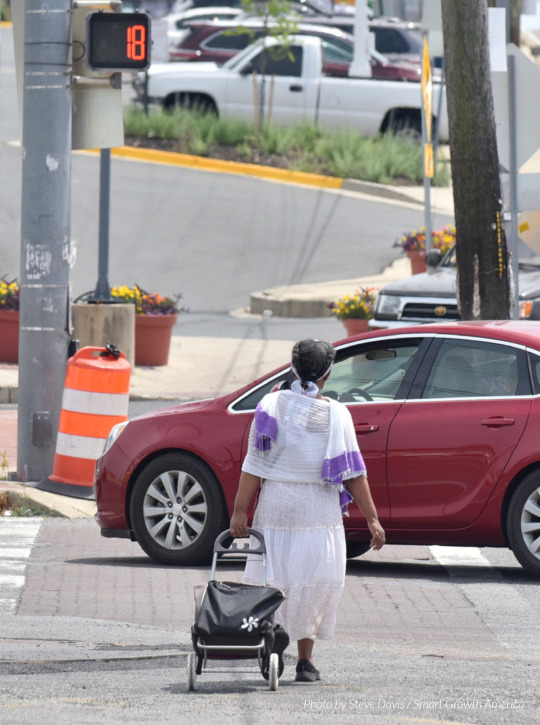
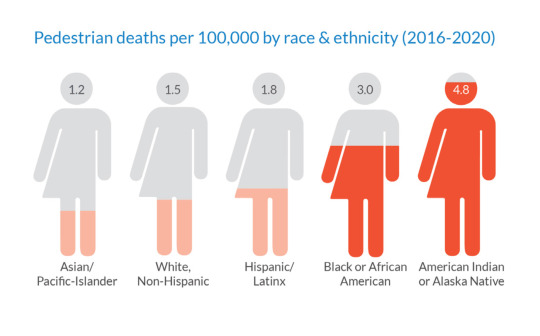

America's Roads: Dangerous by Design
#the link leads to the pdf that i got all these pics + graphics from#very interesting and informative and written in very clear and easy to understand language#please read please reblog this is something im passionate about#mine#pedestrian safety#car centric infrastructure#walkable cities#urbanism#public transportation#urban design
3K notes
·
View notes